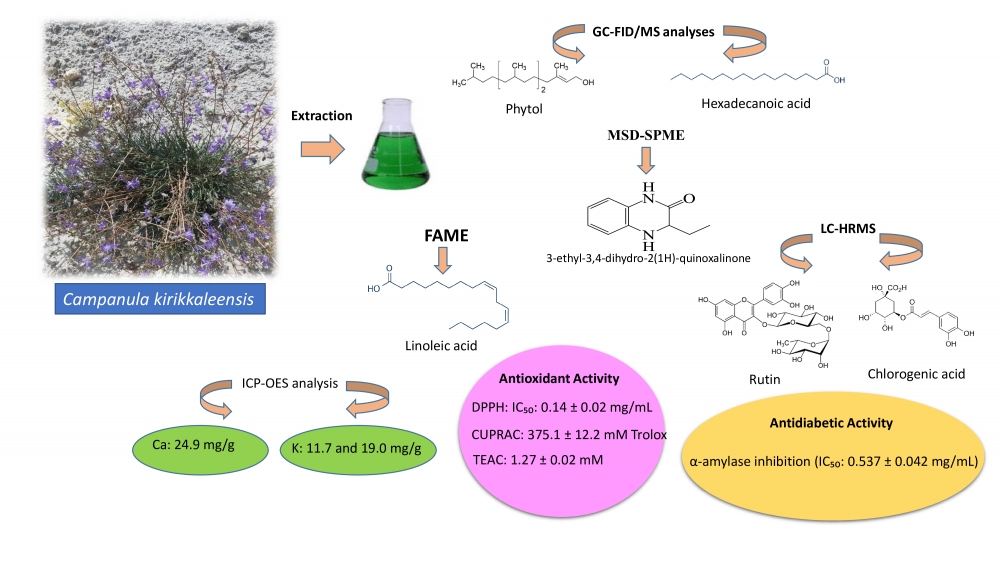Records of Natural Products
A scientific open access journal in the field of natural products.LATEST ARTICLES
GC-MS profiling and in vitro assessment of antioxidant and 5-lipoxygenase inhibitory activities of essential oils from five indigenous Hedychium species in Thailand

The genus Hedychium (Zingiberaceae) consists of rhizomatous aromatic plants widely utilized in Thai traditional medicine and cosmetic formulations. Although recognized ethnopharmacological, the phytochemistry and bioactivity of Thai Hedychium species have great potential for drug development. This study investigated the chemical profiles, in vitro antioxidant capacities, and in vittro 5-lipoxygenase (5-LOX) inhibitory activities of essential oils hydrodistilled from the fresh rhizomes of five Thai species—H. bousigonianum, H. coccineum, H. coronarium, H. ellipticum, and H. flavescens. Gas chromatography–mass spectrometry (GC–MS) analysis revealed distinct, species-specific chemotypes, characterized by α-eudesmol (37.41%) in H. bousigonianum; β-pinene (27.42% and 35.38%, respectively) in H. coccineum and H. flavescens; linalool (26.40%) in H. coronarium; and 1,8-cineole (89.36%) in H. ellipticum. The essential oils from the fresh rhizome of H. bousigonianum, H. coccineum, H. coronarium, H. ellipticum, and H. flavescens demonstrated antioxidant activity across multiple assays. Their free radical scavenging capacity was confirmed by the DPPH assay (IC₅₀ = 17.92 ± 0.62, 20.26 ± 0.53, 20.02 ± 0.89, 18.27 ± 0.60, and 22.12 ± 0.60 µg/mL, respectively) and the ABTS assay (IC₅₀ = 13.16 ± 0.95, 19.02 ± 0.43, 18.09 ± 0.34, 11.81 ± 0.67, and 19.34 ± 0.27 µg/mL, respectively). Similar trends were observed in the superoxide anion (IC₅₀ = 28.41 ± 0.64, 28.96 ± 0.51, 31.47 ± 0.58, 26.19 ± 0.61, and 29.12 ± 0.42 µg/mL, respectively) and hydroxyl radical assays (IC₅₀ = 26.67 ± 0.73, 27.98 ± 0.37, 28.92 ± 0.31, 25.34 ± 0.81, and 32.45 ± 0.55 µg/mL, respectively). Furthermore, the essential oils showed 5-LOX inhibitory activity (IC₅₀ = 57.32 ± 1.09, 67.50 ± 1.70, 60.31 ± 1.25, 55.84 ± 1.53, and 75.34 ± 2.28 µg/mL, respectively), supporting their potential anti-inflammatory properties. Notably, the essential oils from H. bousigonianum and
H. ellipticum showed the most potent dual antioxidant and anti-inflammatory activities, highlighting their promise as natural sources of bioactive compounds for future pharmaceutical development.
test
test
DOI test Keywords test 53453 543534534534 5435435345 DETAILS PDF OF ARTICLE © 2007 ACG Publications. All rights reserved.Comprehensive phytochemical profiling and cell-free in vitro bioactivity assessment of the endemic Campanula kirikkaleensis Dönmez & Güner

This study presents the first comprehensive evaluation of the phytochemical profile and cell-free antioxidant and enzyme inhibitory activities of the endemic Campanula kirikkaleensis Dönmez & Güner. n-Hexane, chloroform, and 70% methanol extracts from aerial parts and roots were investigated for their phytochemical composition and bioactivities. GC-FID/MS analyses revealed phytol (14.2%) as the main volatile in aerial parts and hexadecanoic acid (22.5%) in roots. MSD-SPME identified 3-ethyl-3,4-dihydro-2(1H)-quinoxalinone as the major shared volatile (9.8% in aerial parts; 14.5% in roots). Linoleic acid was the predominant fatty acid in both parts (26.4% in aerial parts; 22.3% in roots). LC-HRMS highlighted rutin (525.29 mg/100g dry plant) in aerial parts and chlorogenic acid (24.78 mg/100g dry plant) in roots as dominant phenolics. The 70% methanol aerial extract showed the strongest antioxidant activity (DPPH IC₅₀: 0.14 ± 0.02 mg/mL; CUPRAC: 375.1 ± 12.2 mM Trolox), while the highest TEAC value was recorded in the chloroform root extract (1.27 ± 0.02 mM). The same methanol extract also demonstrated the most potent α-amylase inhibition (IC₅₀: 0.537 ± 0.042 mg/mL). ICP-OES analysis revealed calcium as most abundant in aerial parts (24.9 mg/g) and potassium in roots and flowers (11.7 and 19.0 mg/g). These findings provide a detailed chemical and bioactivity profile of C. kirikkaleensis, supporting its potential for future pharmacological investigations.
DOI http://doi.org/10.25135/rnp.2509.3644 Keywords Campanula kirikkaleensis phytochemical profile antioxidant activity LC-HRMS GC-FID/MS. DETAILS PDF OF ARTICLE © 2026 ACG Publications. All rights reserved.Uvaol-28-D-(R)-pyroglutamic acid ester: a new triterpenoid compound from Circinellamuscae CGMCC 3.2695 and its activity assessment in transgenic zebrafish

A novel triterpenoid compound named Uvaol-28-D-(R)-pyroglutamic acid ester (UPE) was obtained via microbial biotransformation of uvaol by Circinella muscae CGMCC 3.2695. Its structure was elucidated by spectroscopic and mass-spectrometric analyses, including 1D-, 2D-NMR and HR-ESI-MS. UPE administration promotes intersegmental vessel (ISV) growth and motor neuron development in transgenic zebrafish embryos in a concentration-dependent manner. Furthermore, UPE significantly restored the swimming distance in zebrafish exposed to combretastatin A-4 (CA-4), as assessed by ESOvision behavioral analysis. These findings suggest that UPE holds promise for the treatment of cardiovascular and cerebrovascular diseases.
DOI http://doi.org/10.25135/rnp.2508.3620 Keywords Uvaol-28-D-(R)-pyroglutamic acid ester Circinella muscae CGMCC 3.2695 transgenic zebrafish intersegmental vessel motor neuronal axonal DETAILS PDF OF ARTICLE © 2026 ACG Publications. All rights reserved.
